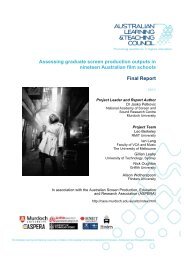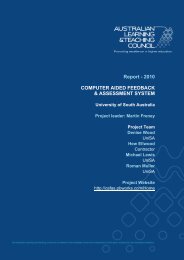Download Document - Office for Learning and Teaching
Download Document - Office for Learning and Teaching
Download Document - Office for Learning and Teaching
You also want an ePaper? Increase the reach of your titles
YUMPU automatically turns print PDFs into web optimized ePapers that Google loves.
a chi-square test to determine whether responses are dependent on theclassification of students.3. Any outcome that returns a p-value of less than or equal to 0.05 will beconsidered as significant, indicating that there is an association between thetwo classifications of students (labelled as “Australia” <strong>and</strong> “not Australia”) <strong>and</strong>the responses to a particular question. By “association” we mean the patternof responses to a particular question from one group of students (“Australia”)is different from the other group (“not Australia”).4. However, the chi-square test only identifies the existence of an association; itdoes not measure the strength of that association. To achieve that we needadditional statistical tests. Given that we are mostly dealing with nominaldata, Phi <strong>and</strong> Cramer’s V are the most suitable tests. The calculation of bothPhi <strong>and</strong> Cramer’s V involves modifying chi-square to take into considerationthe sample size <strong>and</strong> degrees of freedom, <strong>and</strong> their values are restricted tobetween 0 <strong>and</strong> 1, where 0 indicates no association <strong>and</strong> 1 indicates a perfectassociation. The Phi statistic is only accurate <strong>for</strong> 2x2 contingency table.When variables have more than two categories, Cramer’s V is more useful.When variables have only two categories, Phi <strong>and</strong> Cramer’s V are identical.5. As mentioned above, Phi <strong>and</strong> Cramer’s V statistics range from 0 to 1 with 1indicating the highest strength of association. However, there is littleliterature showing the exact interpretation of specific values within that range.For the purpose of this study, we define outcomes with Phi <strong>and</strong> Cramer’s Vvalues less than 0.3 as being too weak an association to be included in theresults.We conduct the correlation analysis on all student data, <strong>and</strong> repeat the process <strong>for</strong>all IT students <strong>and</strong> again <strong>for</strong> all Business students. Output results of the analyses ofthese three groups of students are summarised in Tables 60, 61 <strong>and</strong> 62respectively.In each of these tables, the first column shows the question number from thestudent questionnaire, the second column shows the actual question, the thirdcolumn shows p-values of the chi-square test in cross-tabulation, <strong>and</strong> the fourthcolumn shows the interpretation of p-values with those less than or equal to 0.05being considered as “dependent” – meaning there is an association between thepattern of responses <strong>and</strong> the categories of students (labelled as “Australia” or “notAustralia”). The last column of the table shows the values of Phi & Cramer’s V withvalues higher than 0.3 highlighted. The reason <strong>for</strong> using just one column to displayboth Phi <strong>and</strong> Cramer’s V is that the output from SPSS shows that these two valuesare the same <strong>for</strong> each question.The test hypotheses designed to test the correlation between the two categories ofstudents <strong>and</strong> the responses of each question are shown in Section 4.2.1. The sameset of hypotheses is used <strong>for</strong> the three sets of correlation analyses. The summarisedoutput results of the three sets of analyses are shown in Sections 4.2.2, 4.2.3 <strong>and</strong>4.2.4 respectively.4.2.1 Hypotheses <strong>for</strong> correlation analysesThe name of each hypothesis corresponds to the relevant question number in thestudent survey questionnaire.Hypothesis II.1H0: Student category (local or international) <strong>and</strong> attitude toward textbook significancein learning are unrelated (Independent).46
















